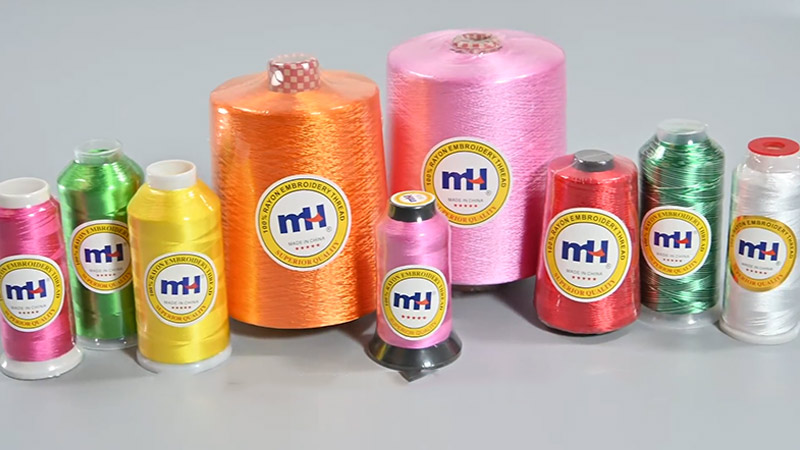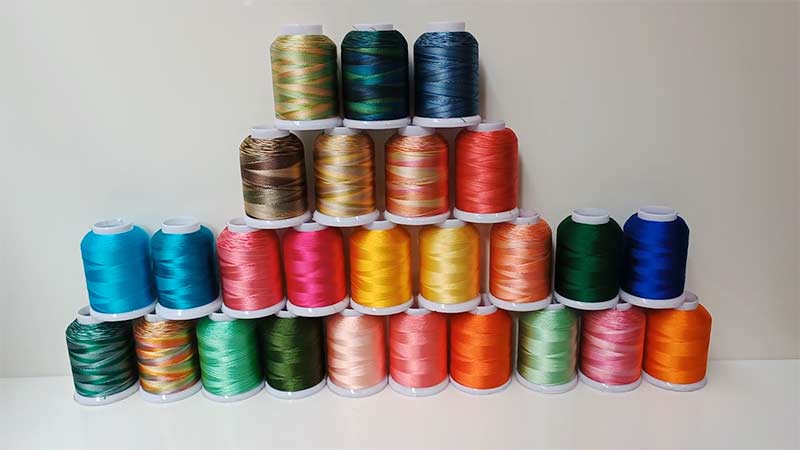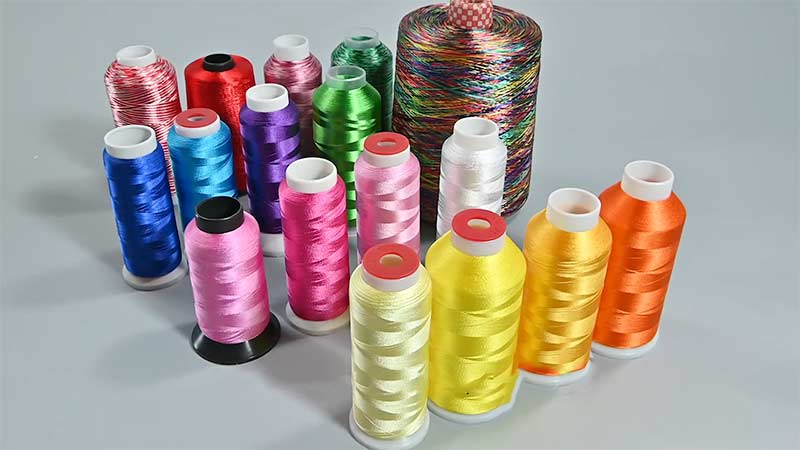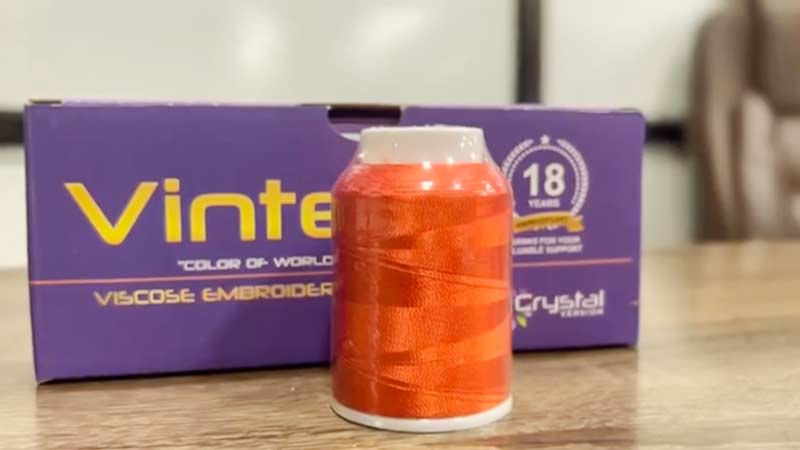Viscose embroidery thread, a luminous and versatile fiber derived from natural cellulose sources, is a popular choice in embroidery.
Renowned for its high sheen, smooth texture, and adaptability, this thread, alternatively known as rayon embroidery or art silk thread, transforms ordinary stitches into intricate works of art.
Its manufacturing process involves crafting a semi-synthetic material from wood pulp or cotton, resulting in a luxurious, silk-like thread.
Widely favored for its ability to enhance color vibrancy and detail, viscose embroidery thread is a go-to option for those seeking an elegant and refined touch in decorative stitching and embroidery projects.

What Is Viscose Embroidery Thread?
Viscose embroidery thread is a lustrous and silky thread made from viscose, a semi-synthetic fiber derived from natural sources like wood pulp or cotton linters.
Also known as rayon embroidery thread or art silk thread, it is valued for its high sheen, smooth texture, and versatility. Widely used in decorative stitching and embroidery, it enhances color vibrancy and adds an elegant touch to projects.
Despite its sensitivity to heat and moisture, viscose embroidery thread remains a preferred choice for those seeking a luxurious and refined aesthetic in their embroidery work.
Characteristics of Viscose Embroidery Thread
Viscose embroidery thread possesses several characteristics that make it popular among embroiderers. These characteristics contribute to its appearance, ease of use, and overall performance in embroidery projects.
Here are the key characteristics of viscose embroidery thread:
High Sheen and Luster
Viscose embroidery thread is known for its high sheen and luster. This characteristic gives the thread a glossy appearance, enhancing the visual appeal of embroidered designs.
Smooth and Silky Texture
The thread has a smooth and silky texture, making it easy to work with. It glides smoothly through fabric and needles, resulting in even and well-defined stitches.
Enhanced Color and Detail
Viscose thread can enhance the colors and details of an embroidery design. Its reflective properties contribute to vibrant and visually appealing finished projects.
Softness and Flexibility
Viscose embroidery thread is soft and flexible, providing a comfortable feel to the finished embroidery. This quality makes it suitable for various embroidery applications, including garments and accessories.
Durability
The thread is durable and resistant to abrasion, making it suitable for projects undergoing frequent washing or wear. It can maintain its color and brightness over time without fading or bleeding.
Versatility
Viscose embroidery thread is versatile and suitable for various fabrics with different embroidery machines. It can be utilized for both hand and machine embroidery.
Elegant Appearance
Due to its high sheen and smooth texture, viscose embroidery thread is often chosen for projects that require a rich and elegant aesthetic. It adds a touch of sophistication to embroidered garments, accessories, and home decor items.
Moderate Weight
Viscose embroidery thread typically has a moderate weight, allowing it to work well with various needle sizes and fabric types.
What Is Viscose Embroidery Thread Made Of?

Viscose embroidery thread is made from a fiber known as viscose, a semi-synthetic material derived from natural sources. The primary raw materials in viscose production are wood pulp or cotton linters.
Here is a breakdown of the manufacturing process and the components involved:
Cellulose Extraction
The process begins with extracting cellulose from natural sources, such as wood pulp obtained from trees or cotton linters, which are short fibers adhering to cottonseeds.
Alkali Treatment
The extracted cellulose undergoes treatment with an alkali, commonly caustic soda (sodium hydroxide). This treatment results in the creation of alkali cellulose.
Carbon Disulfide Treatment
The alkali cellulose is further processed with carbon disulfide, forming a substance known as cellulose xanthate.
Viscose Solution
The cellulose xanthate is dissolved in a solution, producing a thick, viscous liquid known as viscose.
Ripening
The viscose solution ripens, allowing the cellulose xanthate to mature and achieve the desired properties.
Spinneret Extrusion
The ripened viscose is extruded through spinnerets (small nozzles) into a sulfuric acid bath. This process regenerates the cellulose, forming long filaments.
Neutralization and Washing
The filaments are neutralized using chemicals and thoroughly washed to remove any residual substances, ensuring the purity of the regenerated cellulose fibers.
Drawing and Cutting
The regenerated cellulose fibers are drawn, stretched, and cut into staple fibers or spun into yarns, depending on the intended use.
Spinning
The fibers are then spun into threads. The spinning process can be adjusted to achieve specific characteristics such as thickness and twist.
Final Processing
The spun threads may undergo additional processes, including twisting, dyeing, and finishing, to prepare them for use in embroidery.
Types of Projects Are Suitable for Viscose Embroidery Thread

Viscose embroidery thread is versatile and suitable for a wide range of projects that require decorative stitching and intricate embroidery.
Some types of projects that are well-suited for viscose embroidery thread include:
Garments
Viscose thread is commonly used for embellishing garments, such as dresses, blouses, shirts, and skirts. Its high sheen and smooth texture add an elegant touch to the fabric, making it ideal for casual and formal wear.
Accessories
Viscose embroidery thread enhances the aesthetics of various accessories, including scarves, handbags, hats, and shoes. It allows for intricate and detailed embroidery on different materials.
Home Decor Items
Projects involving home decor items, such as pillowcases, bedspreads, curtains, and tablecloths, benefit from the decorative qualities of viscose thread. It adds sophistication and visual interest to interior design elements.
Textile Art
Artists and crafters often use viscose embroidery thread for textile art projects. Whether on canvas or fabric, its vibrant colors and lustrous finish contribute to creating unique and visually appealing pieces.
Traditional and Ethnic Wear
Viscose thread is a popular choice for embellishing traditional and ethnic wear. Its ability to enhance colors and details makes it well-suited for intricate patterns on conventional garments like saris, lehengas, and kurtas.
Lingerie and Undergarments
The soft and silky texture of viscose embroidery thread makes it suitable for delicate items like lingerie and undergarments. It can add a decorative element to intimate apparel.
Monogramming and Lettering
The high sheen of viscose thread makes it ideal for monogramming and lettering on various items, including towels, handkerchiefs, and personalized gifts. It provides a luxurious and personalized touch.
Quilting
Quilters use viscose embroidery thread to add decorative stitching and intricate designs to quilted projects. Its smooth finish enhances the overall appearance of quilts, adding texture and visual interest.
Crafts and DIY Projects
Viscose embroidery thread is versatile for various craft projects, including handmade cards, ornaments, and other do-it-yourself creations where a touch of embroidery is desired.
Fashion Accessories
Viscose thread embellishes fashion accessories such as belts, gloves, headbands, and shoes. It allows designers to add intricate details and elevate the overall style of accessories.
Tips for Using Viscose Embroidery Thread

Using viscose embroidery thread requires careful attention to detail and proper handling to ensure optimal results.
Here are some tips to consider when working with viscose embroidery thread:
Choose High-Quality Thread
Opt for a good quality viscose embroidery thread from a reputable brand. Quality threads are less prone to defects and inconsistencies, ensuring a smoother embroidery.
Select Suitable Needles
Use a suitable needle for viscose embroidery thread. A sharp or universal needle with a large eye and a smooth surface is recommended. The needle size should match the weight of the thread and the fabric.
Use Appropriate Stabilizers
Employ suitable stabilizers for viscose embroidery thread. Stabilizers support the fabric, preventing stretching or puckering during embroidery. Cut-away or tear-away stabilizers are often recommended for added stability.
Adjust Tension Properly
Adjust the tension of your embroidery machine to match the fabric, thread, and design type. Proper tension ensures even and consistent stitches. A balanced tension prevents loose or tight stitches, gaps, puckering, or thread breaks.
Control Machine Speed
Adjust the machine speed according to the complexity of the design, the size of the stitches, and your skill level. A moderate speed allows for better control and accuracy, while high speeds may lead to errors or damage to the thread and fabric.
Mindful Storage
Store viscose embroidery thread in a cool and dry environment to prevent exposure to moisture and humidity. This helps maintain the quality and integrity of the thread, preventing issues like fraying or brittleness.
Thread Management
Be attentive to the thread path and thread flow during the embroidery process. Check for any potential twists or tangles, and guide the thread to prevent knots or breaks. Ensure the thread spool rotates freely to minimize tension issues.
Test on Scrap Fabric
Before starting a new project, conduct a test on a scrap piece of fabric using the same materials and settings. This allows you to observe how the thread interacts with the fabric and make necessary adjustments before embroidering the final project.
Avoid High Heat
Be cautious about exposure to high heat or steam. Viscose embroidery thread is sensitive to heat, and exposure may cause shrinkage or melting. If using an iron, set it to a low temperature and press the fabric on the wrong side.
Maintain Thread Quality
Regularly check the quality of your viscose embroidery thread. If you notice any signs of fraying, splitting, or inconsistency in thickness, consider replacing the thread to ensure the best results in your embroidery work.
FAQs
Can Viscose Embroidery Thread be Used for Both Hand and Machine Embroidery?
Yes, viscose embroidery thread suits hand and machine embroidery, adapting well to different needle types, hoops, and stabilizers.
How Does Viscose Embroidery Thread Compare to Other Thread Types?
Viscose thread is often chosen for its luxurious appearance. Still, users should be aware of its characteristics compared to alternatives like cotton or polyester, considering cost, availability, and application factors.
What Precautions Should I Take When Using Viscose Embroidery Thread?
Precautions include avoiding exposure to high heat, using suitable needles and stabilizers, adjusting machine settings appropriately, and storing the thread in a cool, dry place.
Is Viscose Embroidery Thread Environmentally Friendly?
While derived from natural sources, the manufacturing process involves chemical treatments. Some brands offer eco-friendly options, so checking product specifications is advisable.
Does Viscose Embroidery Thread Shrink After Washing?
Viscose is sensitive to moisture, but the extent of shrinkage may vary. It’s advisable to pre-test the thread on a small fabric swatch before incorporating it into a project that requires washing.
To Recap
Viscose embroidery thread emerges as a captivating fusion of natural origins and modern craftsmanship, offering embroiderers a canvas to weave brilliance into their creations.
Its inherent high sheen, silky texture, and adaptability make it a sought-after choice, elevating the aesthetic appeal of garments, accessories, and home decor.
Despite considerations like sensitivity to heat, its ability to transform ordinary fabric into a tapestry of intricate details remains unparalleled.
As artisans navigate the diverse embroidery landscape, viscose thread is a testament to the enduring allure of traditional craftsmanship enhanced by contemporary innovation, leaving an indelible mark on the world of textile artistry.
Leave a Reply